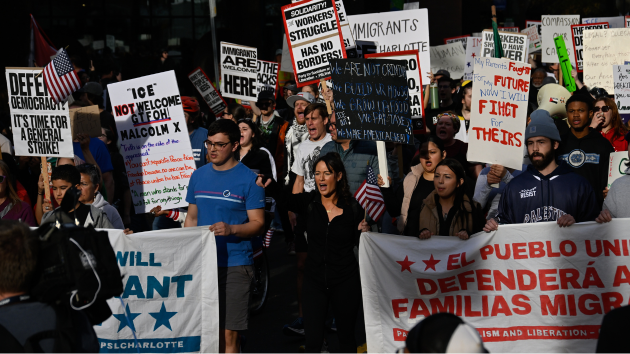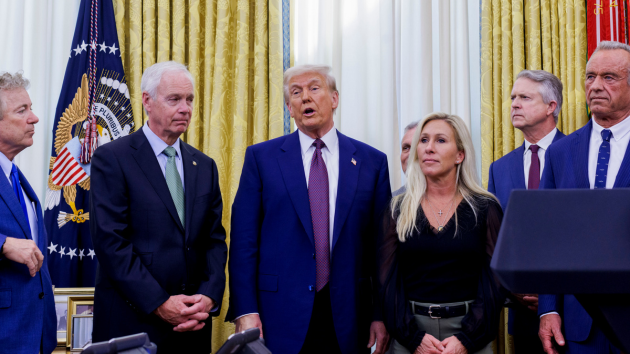What can drivers expect in 2023? Dealer markups, record EV sales and massive V8s.
Written by ABC Audio. All rights reserved. on December 27, 2022
(NEW YORK) — The 2022 global semiconductor crisis was maddening for motorists: record-high prices, months-long delays and hefty dealership markups. Automakers were forced to park new cars and trucks in vacant lots, unable to sell them because of missing parts or software. Consumers also watched as fuel prices reached unprecedented levels.
Interest in electric vehicles reached a fever pitch in 2022, with revolutionary models like the Ford F-150 Lightning, Kia EV6 and Hummer EV drumming up interest among consumers. Automakers also answered enthusiasts’ pleas, rolling out sports cars and hatches with manual transmissions, powerful V8s and high-revving naturally aspirated engines.
Will 2023 be a repeat of 2022? Here’s what the experts are saying:
Car prices
Consumers shopping for deals on a new vehicle in 2022 were out of luck; horror stories of fellow buyers paying $10K, $20K or $50K above MSRP were widely reported. Moreover, the average transaction price (ATP) for a new vehicle hit $47,681 in November — a record high, according to Edmunds. Monthly lease payments also jumped to $583 in November compared to $471 in November 2019.
Jaw-dropping prices, however, may finally be ending, according to Jessica Caldwell, Edmunds’ executive director of insights.
“Prices have been really high for over a year now but are starting to cool,” she told ABC News.
The average transaction price of a new vehicle in November dipped below MSRP for the first time since July 2021, she said, and prices for large trucks, SUVs and luxury vehicles have fallen in recent weeks as consumers search for budget-friendly alternatives. Rising interest rates on auto loans have also dampened demand for expensive conveyances.
“Interest rates are a big deterrent … you’re dedicating more of your income to a car payment,” she said. “This is leading to a softening of the market.”
New vehicle loans are averaging 6.6% and 10.2% for used cars, according to Edmunds data.
Ed Kim, president and chief analyst of AutoPacific, said a recession — even a moderate one — would put a dent in prices and demand next year.
“We may enter a situation where supply comes back but this time there won’t be the number of consumers to support the volume,” he told ABC News.
Inventory returns
Sparse inventory and manufacturing slowdowns turned the automotive industry upside down. Some marques like Toyota have alerted investors and customers that persistent shortages will hamper production of key vehicles in 2023.
“Chips will be a story in the first half of the year,” Tyson Jominy, vice president of data and analytics at J.D. Power, told ABC News.
Jominy, however, predicts inventory will generally rise in 2023, leading to a greater supply of vehicle choices and better prices. But too much supply could presage a return of heavy incentives and lower profits.
“Automakers are trying to be disciplined and tight with inventory,” he said.
Kim said China’s decision to relax its “zero-COVID” policy will help ease chip and supply headaches that have plagued automakers since 2020.
“We won’t be constrained in 2023 like we were in 2022,” he noted. “But there can still be a long lead time for chips — up to six to nine months until one is delivered or installed in a vehicle.”
He added, “As chip supply comes back, there will be a priority on finishing up those vehicles sitting in big, empty fields and getting them out the door to customers.”
Ultra-luxe demand
The chip shortage and ongoing pandemic did not stop high-end automakers like Rolls-Royce, Bentley and Lamborghini from selling thousands of vehicles. All three are expected to beat their sales totals from 2021, a record year for the storied brands.
“We have no slowdown in sales. Every month we’re selling more cars than we’re able to deliver,” Lamborghini CEO Stephan Winkelmann told ABC News.
Recent models like the Rolls-Royce Ghost Black Badge, Bentley Flying Spur Hybrid and Bentayga Extended Wheelbase and Lamborghini Urus S and Urus Performante have brought in new and deep-pocketed customers.
The entire luxury space did exceptionally well in 2022.
“Land Rover sold 5,116 vehicles in November with nearly no incentives. Average price paid: More than $95,000. Slow down? What slow down?” Cox Automotive said in a newsletter to clients.
Consumers who can afford six-figure vehicles are still flush with cash and will likely keep up their buying spree, Kim said.
“People at that income level are well shielded from traditional economic cycles. A recession won’t impact ultra-luxe brands,” he noted.
Enthusiast cars and big V8s
Automakers sneakily revealed a bevy a sports cars and high-performance utes that did not cater to the EV audience. There was the massive debut of the Corvette Z06, a sports car with a naturally aspirated 5.5-liter flat-plane crank V8 engine that revs to 8,500 rpm.
Manual lovers had so many new models to choose from: the Nissan Z; Toyota GR Supra, GR 86 and GR Corolla; BMW M2; Porsche 911 Carrera T; Honda Civic Type R; and Cadillac CT5-V and CT4-V Series Blackwings.
Electrification did not stop the production of thirsty V8 engines in SUVs. British automaker Aston Martin introduced its fast DBX 707, an exclusive SUV designed to give a track-like experience even on short jaunts around town. The 4.0-liter twin-turbo V8 (697 horsepower) delivers luscious acoustics and the race start launch-control function scares drivers and passengers alike.
General Motors launched its opulent Cadillac Escalade to the Escalade V Series, hailed as the “most powerful full-size SUV in the industry.” The 6.2-liter supercharged V8 in the Escalade V produces 682 hp and hustles from 0-60 mph in 4.4 seconds. There was also the all-new GMC Yukon Denali Ultimate, a seven or eight passenger SUV equipped with the latest tech, a 6.2-liter V8 and a 10-speed automatic.
Lexus opted for a V8 in its sleek IS 500 sedan and the fifth-generation Range Rover, Land Rover’s flagship SUV, has three powertrain options, including a V8.
Jominy said the maligned V8 may have a longer shelf-life than expected in an increasingly electric world.
“It’s a space where consumers are more reluctant to swap,” he said. “Anything with three or four cylinders will be replaced with an EV.”
EV market share
So many new electric vehicles were launched in 2022 that it can be hard for consumers to keep track. None, however, were Teslas. We saw electrics in a range of categories: pickup trucks (GMC Hummer EV and Ford F-150 Lightning), stylish crossovers (Audi Q4 e-tron, Kia EV6), plushy utes (BMW iX, Cadillac Lyriq, Rivian R1S) and sporty sedans (BMW i4, Taycan GTS).
The biggest story for 2023 will be the number of three-row electric SUVs on the market, Kim said. Millennials are more likely to buy an EV than Gen Xers or Baby Boomers and many millennials are now “reaching peak income and peak family raising years,” he explained.
“Right now there’s only the Tesla Model X … the market is really lacking in electric three-row products,” he said. “In the next 12 months we’ll get the Hyundai IONIQ 7, Kia EV9, VinFast VF9 and an electric Explorer. All these vehicles will address an unmet need.”
EV supply could not meet market demand in 2022. Caldwell said even more consumers will begin to shift to greener vehicles in 2023, boosting EV share from the current 5% (up from 2.5% in 2021).
“A lot of EVs are coming next year,” she said. “Chevy is doing a massive push with the Silverado and Equinox and Blazer — these are volume vehicles. More body styles are coming and so is better availability of popular models like the IONIQ 5.”
Jominy said he’s waiting to see if lower fuel prices will temper demand for EVs and how automakers respond to the Inflation Reduction Act that President Joe Biden signed into law in August.
“If you’re an automaker and don’t have a U.S. plant [that can build electric batteries] that could be tough,” he said. “But the awareness and intent to buy an EV is growing. The biggest challenge for EVs is that gasoline prices have fallen pretty precipitously.”
The decision by Tesla CEO Elon Musk to open the company’s acclaimed Supercharger network to competitors may be the real reason more consumers ditch their gas-powered vehicles for electrics, argued Kim.
“Range anxiety and charge times are still the top reasons why people don’t want to go electric,” he said. “Tesla’s biggest competitive advantage is its charging network. We’ll see a lot more automakers adopt the [North American Charging Standard], which allows, in theory, a Tesla-like charging experience.”
Copyright © 2022, ABC Audio. All rights reserved.





